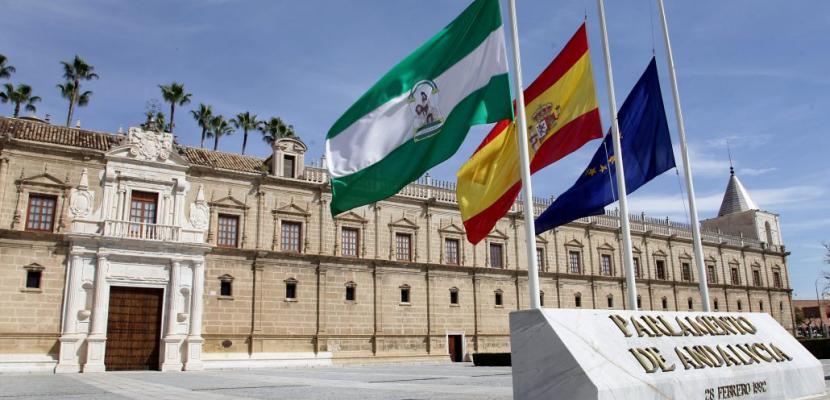Image

Geothermal heating and cooling at the Regional Parliament of Andalusia
Published on 03 November 2018

Spain
Andalucía
This is the good practice's implementation level. It can be national, regional or local.
About this good practice
The Andalusian Parliament is located in Seville, the capital city of Andalusia. Its building is the former historic “Five Wounds Hospital”, built in 1546 and renovated in 1992.
Sevilla has a Mediterranean-oceanic climate with short mild and wet winters and long, hot, dry summers, being the hottest spot in Europe. Cooling needs are essential but heating in winter is necessary as well.
Heating and cooling needs are served by very low enthalpy geothermal energy (heat pump) by exchanging energy water-to-water with an underground shallow waters reservoir lying 10-20 meters above the ground at a very constant temperature of 18-22ºC along the year. There is no water consumption (close circuit). This temperature stability is critical for a high performance. This way, the water reservoir acts as a “seasonal heat reservoir” in a much more much more efficient way than standard air-to-air model.
Heat is extracted from underground waters in winter (18ºC underground temperature, 5ºC typically outdoors) and re-injected in summer (22ºC underground temperature, 40ºC typically outdoors). Standard air-based heat pumps, on the contrary, operate poorly during heat waves that often raise temperatures above 40º during summer.
The reservoir intake is separated 150m from the re-injection zone to assure a very constant temperature and, therefore, avoid the thermal depletion by assuring a regenerative cycle.
This is an example of incorporating high technology to historic buildings
Sevilla has a Mediterranean-oceanic climate with short mild and wet winters and long, hot, dry summers, being the hottest spot in Europe. Cooling needs are essential but heating in winter is necessary as well.
Heating and cooling needs are served by very low enthalpy geothermal energy (heat pump) by exchanging energy water-to-water with an underground shallow waters reservoir lying 10-20 meters above the ground at a very constant temperature of 18-22ºC along the year. There is no water consumption (close circuit). This temperature stability is critical for a high performance. This way, the water reservoir acts as a “seasonal heat reservoir” in a much more much more efficient way than standard air-to-air model.
Heat is extracted from underground waters in winter (18ºC underground temperature, 5ºC typically outdoors) and re-injected in summer (22ºC underground temperature, 40ºC typically outdoors). Standard air-based heat pumps, on the contrary, operate poorly during heat waves that often raise temperatures above 40º during summer.
The reservoir intake is separated 150m from the re-injection zone to assure a very constant temperature and, therefore, avoid the thermal depletion by assuring a regenerative cycle.
This is an example of incorporating high technology to historic buildings
Expert opinion
This is a good example of introducing non-invasive renewable technologies into a historic building. The use of technology – heating and cooling system using low-enthalpy geothermal energy – is a perfect fit for the building and climate. As noted, transferability will rely on availability of geothermal resources. Other regions can take this as an example though of how to integrate low-carbon principles whilst also respecting cultural and historic heritage.
Works at
Interreg Europe Policy Learning Platform
Resources needed
For a total power of approximately 5 MW of refrigerating production equipment, the cost of the wells was approximately 345,000€. The budget includes water extraction and reinjection wells, as well as a network of buried pipelines. The project was financed by Parliament´s own funds.
Evidence of success
The solution assures high comfort, energy savings and less GHG emissions compared to standard HVAC. It saves energy both in winter and summer due to the energy demand reduction, and also in mild seasons as there is simultaneous production of both heating and cooling depending on the building zones.
External extreme temperatures do not affect the performance of the heat pumps because the water reservoir keeps a stable temperature.
Sensible water savings compared to standard air-air HVAC .
External extreme temperatures do not affect the performance of the heat pumps because the water reservoir keeps a stable temperature.
Sensible water savings compared to standard air-air HVAC .
Potential for learning or transfer
This practice is an example of the availability of incorporating high technology to historic buildings.
Factors that might hamper the transfer:
o Availability of an underground water reservoir. Nevertheless, a bed rock model could work in its absence.
o Initial larger investment could hamper the transfer. Though equipment related to sustainable building requirements is getting cheaper, it demands higher investment costs that need to be financed. Fortunately, private banks seem to be lately more sensitive to finance “green projects”.
o Heritage restrictions on historical buildings.
o Environmental regulation on drilling works and underground water bodies
Factors that might hamper the transfer:
o Availability of an underground water reservoir. Nevertheless, a bed rock model could work in its absence.
o Initial larger investment could hamper the transfer. Though equipment related to sustainable building requirements is getting cheaper, it demands higher investment costs that need to be financed. Fortunately, private banks seem to be lately more sensitive to finance “green projects”.
o Heritage restrictions on historical buildings.
o Environmental regulation on drilling works and underground water bodies
Further information
Website
Good practice owner
You can contact the good practice owner below for more detailed information.
Organisation
Regional Government of Andalucía

Spain
Andalucía
Contact
Head of Unit
